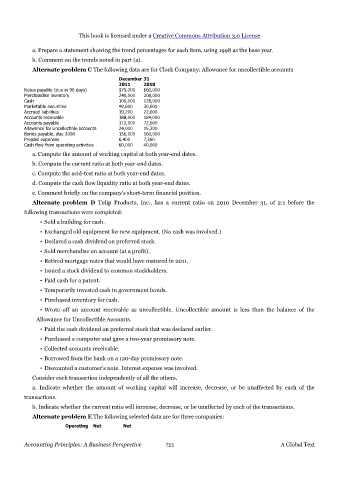Page 720 - Accounting Principles (A Business Perspective)
P. 720
This book is licensed under a Creative Commons Attribution 3.0 License
a. Prepare a statement showing the trend percentages for each item, using 1998 as the base year.
b. Comment on the trends noted in part (a).
Alternate problem C The following data are for Clock Company: Allowance for uncollectible accounts
December 31
2011 2010
Notes payable (due in 90 days) $75,200 $60,000
Merchandise inventory 240,000 208,000
Cash 100,000 128,000
Marketable securities 49,600 30,000
Accrued liabilities 19,200 22,000
Accounts receivable 188,000 184,000
Accounts payable 112,000 72,000
Allowance for uncollectible accounts 24,000 15,200
Bonds payable, due 2008 156,000 160,000
Prepaid expenses 6,400 7,360
Cash flow from operating activities 60,000 40,000
a. Compute the amount of working capital at both year-end dates.
b. Compute the current ratio at both year-end dates.
c. Compute the acid-test ratio at both year-end dates.
d. Compute the cash flow liquidity ratio at both year-end dates.
e. Comment briefly on the company's short-term financial position.
Alternate problem D Tulip Products, Inc., has a current ratio on 2010 December 31, of 2:1 before the
following transactions were completed:
• Sold a building for cash.
• Exchanged old equipment for new equipment. (No cash was involved.)
• Declared a cash dividend on preferred stock.
• Sold merchandise on account (at a profit).
• Retired mortgage notes that would have matured in 2011.
• Issued a stock dividend to common stockholders.
• Paid cash for a patent.
• Temporarily invested cash in government bonds.
• Purchased inventory for cash.
• Wrote off an account receivable as uncollectible. Uncollectible amount is less than the balance of the
Allowance for Uncollectible Accounts.
• Paid the cash dividend on preferred stock that was declared earlier.
• Purchased a computer and gave a two-year promissory note.
• Collected accounts receivable.
• Borrowed from the bank on a 120-day promissory note.
• Discounted a customer's note. Interest expense was involved.
Consider each transaction independently of all the others.
a. Indicate whether the amount of working capital will increase, decrease, or be unaffected by each of the
transactions.
b. Indicate whether the current ratio will increase, decrease, or be unaffected by each of the transactions.
Alternate problem E The following selected data are for three companies:
Operating Net Net
Accounting Principles: A Business Perspective 721 A Global Text

